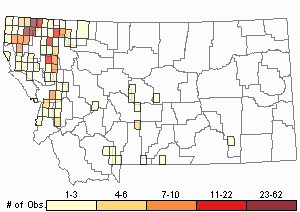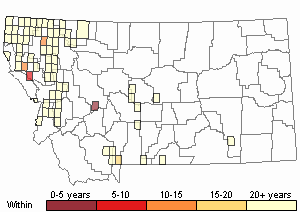View in other NatureServe Network Field Guides
NatureServe
Montana
Utah
Wyoming
Idaho
Wisconsin
British Columbia
South Carolina
Yukon
California
New York
A Dicranum Moss - Dicranum scoparium
Other Names:
Broom Fork Moss
General Description
Plants: Acrocarpous (Vitt 1988). Growing in open to crowded clumps of erect shoots, pale to deep green, occasionally shiny. Stems 2-10 cm tall; rhizoids pale to brown, forming woolly mats on the stem (FNA 2007).
Leaves: Shape quite variable, a little curved and twisted when dry, typically curved and pointing toward one side of the stem, seldom straight and upright, most often smooth but occasionally with crosswise waves, lance-shaped, cupped below, longitudinally ridged above, 4-15 mm in length, 0.8-1.8 mm in width; apex acute or broader; margins typically saw-toothed above, seldom finely so to subentire; costa ending just before to slightly beyond the apex, typically with 2-4 dentate crests on the dorsal side (FNA 2007) from about mid-leaf to the apex (Lawton 1971), although the crests are nearly vanished in some forms (FNA 2007).
Leaf Cells: Lamina 1 cell-layer thick, the cells smooth and the walls between the cells not protruding; upper laminal cells wavy and porose; lower laminal cells very thin and quadrangular, porose, longer than the upper cells; alar cells distinct, inflated, occasionally reaching the nerve, the alar area 2 cell-layers thick; costa in X-section with guide cells in 1 row, the ventral and dorsal stereid bands both narrow, the ventral superficial cells not distinct, the dorsal superficial cells interspersed with a few bigger cells that are part of the dentate dorsal crest, not reaching the apex (FNA 2007).
Phenology
Fruit ripens in spring (FNA 2007).
Diagnostic Characteristics
The variable leaves are mostly lance-shaped with a long acumen, but occasionally are ovate-lanceolate with a short acumen. Plants in the far north and those in wetlands often develop leaves with superficial differences (FNA 2007).
D. scoparium plants that are sterile and big-leaved may resemble D. majus. The costal anatomy of the two species differs on several points, one concerning the guide cells (in 2 rows in D. majus instead of 1). Also, when fruit is present, D. majus presents 2-5 sporophytes in a perichaetium rather than the 1, or seldom 2, of D. scoparium (FNA 2007).
Range Comments
North American Range
Canada: YT and BC to NL and NS; USA: AK and nearly all of the continental states (unknown in NV, ND, and TX); Mexico (FNA 2007). Known in Montana from Carbon, Cascade, Custer, Fergus, Flathead, Gallatin, Glacier, Granite, Lake, Lewis and Clark, Lincoln, Madison, Missoula, Park, Ravalli, Sanders, and Sweet Grass Counties (Elliott 2016).
Observations in Montana Natural Heritage Program Database
Number of Observations: 354
(Click on the following maps and charts to see full sized version)
Map Help and Descriptions
Relative Density

Recency



 (Observations spanning multiple months or years are excluded from time charts)
(Observations spanning multiple months or years are excluded from time charts)
Habitat
Humus overlying rock, soil, rotten wood, bottoms of trees in forests, occasionally wetlands. Elevation: 160-9510 feet (FNA 2007).
Reproductive Characteristics
Dioicous or sometimes small males growing on female plant rhizoids. Inner perichaetial bracts enveloping the stem, suddenly narrowing to the long acumen. Seta single or seldom 2 in a perichaetium, ochre to russet, 20-40 mm tall. Capsule bowed, tilted to level, ochre to russet, smooth or finely longitudinally-ridged when dry, 2.5-4 mm in length; peristome of 16 teeth, separated ca halfway down into 2 lobes (seldom 3), russet, with papillae above. Calyptra hood-like, hairless, sheltering much of the capsule, falling away easily (FNA 2007).
Stewardship Responsibility
References
- Literature Cited AboveLegend:
 View Online Publication
View Online Publication Elliott, J.C. and A.K. Pipp. 2018. A Checklist of Montana Mosses (1880-2018). Updated 3 January, 2020. Montana Natural Heritage Program, Helena, Montana. 73 pp.
Elliott, J.C. and A.K. Pipp. 2018. A Checklist of Montana Mosses (1880-2018). Updated 3 January, 2020. Montana Natural Heritage Program, Helena, Montana. 73 pp. Flora of North America Editorial Committee, eds. 2007. Flora of North America North of Mexico. Volume 27. Bryophytes: Mosses, Part 1. Oxford University Press, Inc., NY. xxi + 713 pp.
Flora of North America Editorial Committee, eds. 2007. Flora of North America North of Mexico. Volume 27. Bryophytes: Mosses, Part 1. Oxford University Press, Inc., NY. xxi + 713 pp. Lawton, E. 1971. Moss Flora of the Pacific Northwest. Hattori Botanical Laboratory. Japan: Yamabuki-cho, Shinjuku-ku, Tokyo. 362 pages plus appendices.
Lawton, E. 1971. Moss Flora of the Pacific Northwest. Hattori Botanical Laboratory. Japan: Yamabuki-cho, Shinjuku-ku, Tokyo. 362 pages plus appendices. Vitt, D. J. Marsh, and R. Bovey. 1988. Mosses, Lichens & Ferns of Northwest North America. Seattle, WA: University of Washington Press. 296 p.
Vitt, D. J. Marsh, and R. Bovey. 1988. Mosses, Lichens & Ferns of Northwest North America. Seattle, WA: University of Washington Press. 296 p.
- Additional ReferencesLegend:
 View Online Publication
View Online Publication
Do you know of a citation we're missing? Crum, H.A. and L.E. Anderson. 1981. Mosses of Eastern North America. 2 volumes. Columbia University Press, New York. 1328 pp.
Crum, H.A. and L.E. Anderson. 1981. Mosses of Eastern North America. 2 volumes. Columbia University Press, New York. 1328 pp. Elliot, J. C. 1993. Second checklist of Montana mosses. Unpublished report. U.S. Forest Service, Region 1. Missoula, MT. 45 pp.
Elliot, J. C. 1993. Second checklist of Montana mosses. Unpublished report. U.S. Forest Service, Region 1. Missoula, MT. 45 pp. Flowers, S. 1973. Mosses: Utah and the West. Brigham Young University, Provo, Utah. 567 p.
Flowers, S. 1973. Mosses: Utah and the West. Brigham Young University, Provo, Utah. 567 p. Lawton, E. 1971. Keys for the Identification of the Mosses on the Pacific Northwest. Reprinted from 'Moss Flora of the Pacific Northwest'. Published as Supplement No. 2 of the Journal of the Hattori Botanical Laboratory. Nichinan, Miyazaki, Japan. 66 pp.
Lawton, E. 1971. Keys for the Identification of the Mosses on the Pacific Northwest. Reprinted from 'Moss Flora of the Pacific Northwest'. Published as Supplement No. 2 of the Journal of the Hattori Botanical Laboratory. Nichinan, Miyazaki, Japan. 66 pp. Malcolm, B., N. Malcolm, J. Shevock, and D. Norris. 2009. California Mosses. Nelson, New Zealand: Micro-Optics Press. 430 pp.
Malcolm, B., N. Malcolm, J. Shevock, and D. Norris. 2009. California Mosses. Nelson, New Zealand: Micro-Optics Press. 430 pp. Smith, A.J.E. 1980. The Moss Flora of Britain and Ireland. Cambridge University Press, Cambridge. 705 pp.
Smith, A.J.E. 1980. The Moss Flora of Britain and Ireland. Cambridge University Press, Cambridge. 705 pp.
- Web Search Engines for Articles on "A Dicranum Moss"





